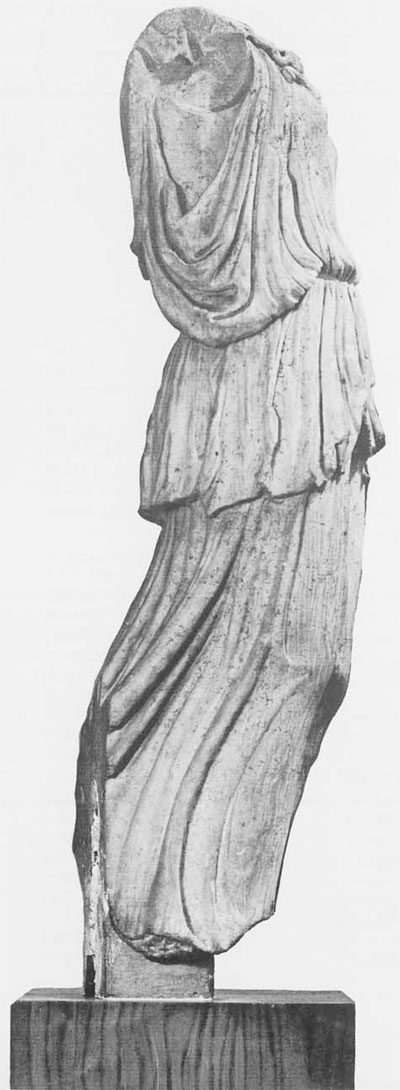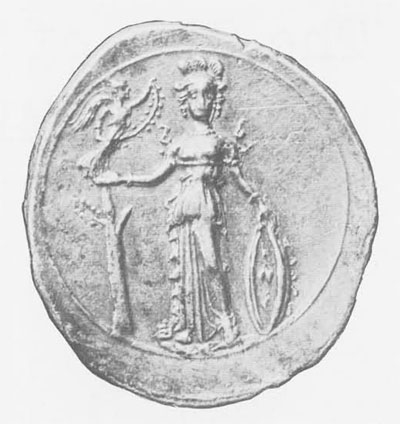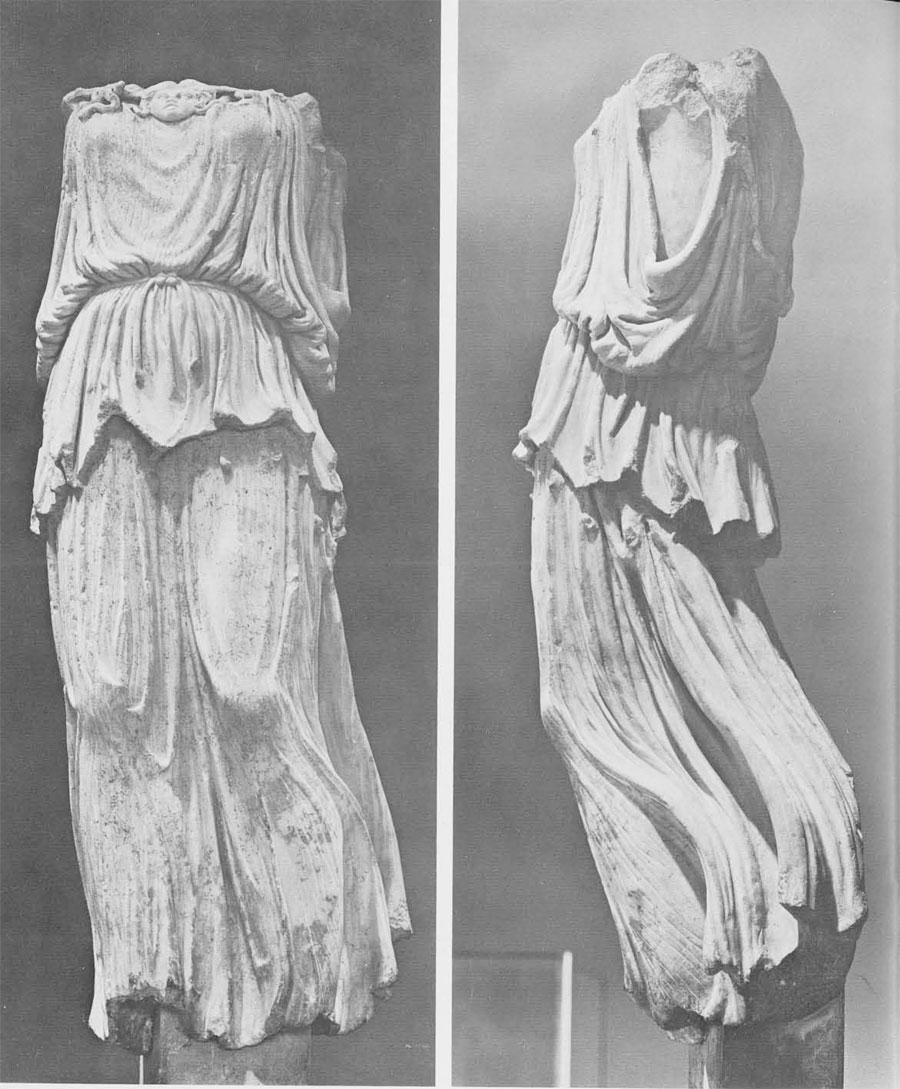

In 438 B.C. there was dedicated in the Parthenon at Athens the colossal gold and ivory statue of Athena, one of the major works of Pheidias, commissioned by Pericles. Of this majestic statue, over forty feet high, the cult image of the goddess for nearly a thousand years, only a few copies in other materials, of moderate or miniature size, have hitherto remained to give us an impression of the fascination the original held for the ancients. Mr. Carpenter’s identification of the Pitcairn Nike as a full size copy of the figure of Victory which was shown symbolically alighted on the hand of Athena brings us in scale and in visual impact within view of one of the great glories of the ancient world.
Until the nineteenth century, broken statues surviving from Greek or Roman times were very generally restored to respectable sculptural status by having their missing parts supplied at the discretion of some restorer. Thus, the Aeginetan Marbles from the pediments of an early fifth century Greek temple were very skillfully (and quite disastrously) restored some hundred and fifty years ago by the famous sculptor Thorwaldsen. However, the Elgin Marbles, which were brought at much the same time to London, suffered no such “improvement” and, except for occasional cleaning, may still be seen in the same state in which they were removed from the Parthenon. Since then, it has been an unwritten law that Classical antiquities must not be altered by modern hands.
Nevertheless the professional student of Greek sculpture continues to restore the broken statues which come to his attention. Naturally, he cannot do this in physical actuality of added marble, but performs the feat mentally (which is not very reliable), or by sketches on paper (which is somewhat better), or by a fully carried-out reconstruction in plaster (which is by far the best method–if he is up to it!). Such exploratory reconstructions very generally have to amend routine losses through fracture and contusion incurred centuries ago when the statue was overturned from its pedestal. But there are also problems of another sort, where a statue had originally been put together out of separately carved pieces, some of which have been lost. This is the class to which the large marble fragment belongs, which has for several years been on loan to the Museum from its owner, Mr. Raymond Pitcairn or Bryn Athyn, and is now conspicuously mounted on a lofty pedestal in the Classical Gallery.
At first glance a wreck of a figure, this piece will prove on closer examination to be virtually undamaged, with detail intact and surface in excellent preservation. Only (alas!), eight complementary pieces which once were attached have been lost beyond recovery. Their list comprises: a head and neck; two bare arms to the shoulders; item, a pair of wings (once bedded in the shoulder-blades and serving to prove that the figure is a Victory, or Nike); item, a bit of drapery attaching to the lower rear; and last (but as it turns out, by no means least) a pair of feet projecting from beneath the long trailing peplos gown.
It may be inferred from the various traces of the means by which these missing parts were once held in place that the right arm was lowered, that the left arm was sharply raised and extended forward, and that the wings were closed in back, not spread for flight. The head was erect and slightly bent forward. The feet–or, at least, as much of them as was visible–had been carved separately and pegged into position. And these, which may seem the least interesting element in the reconstruction, are actually its most informative clue.
A few years ago our statue was removed from its mounting in order to reset it in the newly arranged Classical Gallery; and at that time a curious and hitherto unappreciated detail was exposed. In the under side of the block there was a large square cutting in which the marble had been hollowed out to a depth of two and a half inches. This indicated that the statue had not originally been mounted in normal manner upon a level pedestal, but elevated on some sort of standard or central support. The purpose of this may have been to raise the Victory aloft, as though she were in floating flight in the air; but the closed wings would be inappropriate to such an act, and the explanation takes no account of the separately carved and attached feet, which perfectly well and much more conveniently could have been cut in the marble block of the main body. It was further apparent that only the front half of the feet, from instep to toes, had been fashioned, as the large central cutting interrupted any further extension of them inward. In consequence, the entire weight of the statue must have been carried on the square central support, and none of it permitted to bear down on the lightly suspended projecting feet. There is only one plausible explanation for this seemingly unnecessary and troublesome procedure: the feet could not have been made of marble, because otherwise they would surely have been cut in one piece with the rest of the main block.
At various points on the surface of the statue there still adhere some tiny and barely discoverable patches of bright vermilion color. These do not prove that the Nike once wore a garment of brilliant red. The coloring matter is cinnabar, which is red sulphide of mercury (HgS in chemical terms) and possesses an affinity for gold which made it useful in antiquity as a binding medium for gilding bronzes. It was also employed in Roman times as a sizing for attaching gold leaf to marble. Our Nike, therefore, was once clad, not in red, but in cloth of gold. Of what, then, were the nude parts of her body if–on the testimony of the missing feet–these were not marble? The golden drapery suggests an answer. The statue should be a copy in less precious materials from an original in gold and ivory, the medium known as “chryselephantine” and employed in the fifth and fourth centuries B.C. as a rare and costly resource for temple statuary of the gods. In the present instance, some such chryselephantine figure has been economically reproduced by substituting gilded marble for the solid gold plates of the draped portions of the original and replacing the yellowed ivory of the nude parts by some cheaper substance such as alabaster. (The wings may have been reproduced in thin wooden board, overlaid with gold leaf, or, less probably, added in gilded stucco.)
And here the plot thickens, since it is possible to guess what chryselephantine cult statue in what ancient temple has here been copied in alabaster and gilded marble.
The specialist in Greek sculpture can be fairly readily persuaded that, stylistically, the Pitcairn Nike is closely related to one of the Elgin Marbles and specifically to the running figure with wind-blown drapery from the left wing of the east pediment of the Parthenon, officially labelled, “G,” unofficially called Iris, and probably identifiable as the Greek birth-goddess Eileithyia. Many of the details in the rendering of the draped form are so similar that they force a conclusion that the chryselephantine original which our statue reproduced was an Attic work very little earlier than the Parthenon pedimental statues and, as such, datable around 440 B.C. But in that case there is only one possible source for this Nike–the life-sized gold-and-ivory Victory alighting on the outstretched hands of the colossal gold-and-ivory statue of Athena made by Pheidias and housed in her temple, the Parthenon.
A coin from the collection of the late E.T. Newell reproduces in miniature relief an almost contemporary version of this famous statue, judged to be a faithful replica erected early in the fourth century B.C. in the Asia Minor city of Aphrodisias (which issued the coin). Since the details of the statue in the Parthenon seem to have been scrupulously embodied in the pose and adornments of the standing goddess shown on the coin, the winged victory on her out-stretched hand should be equally faithful to its original. In order to find space for her in the circular medallion, the coin designer has tilted her forward out of balance; but otherwise she should give us a very exact picture of how the statue in the Museum is to be restored, with wings closed behind her back and an olive branch suspended between her lowered right and her upraised left hand. We can only guess vaguely at the appearance of her head and the features of her face, as the coin is too small and too poorly executed to give us much information on this score. But the missing block of drapery at the bottom rear of the statue not only can be supplied from the coin but can be restored by adopting, almost without change, the flowing curves of the Elgin Marble of Eileithyia.
So–or, at least, so in the opinion of the writer of this brief report–the Clue of the Missing Feet leads to the solution of a complicated mystery and confers unusual historic interest and great artistic importance on a statue in the Museum which (it may be hoped) will not hereafter be passed by without due deference. There is no other full-size copy of the Nike of the Parthenon.

Photographs by: Reuben Goldberg
